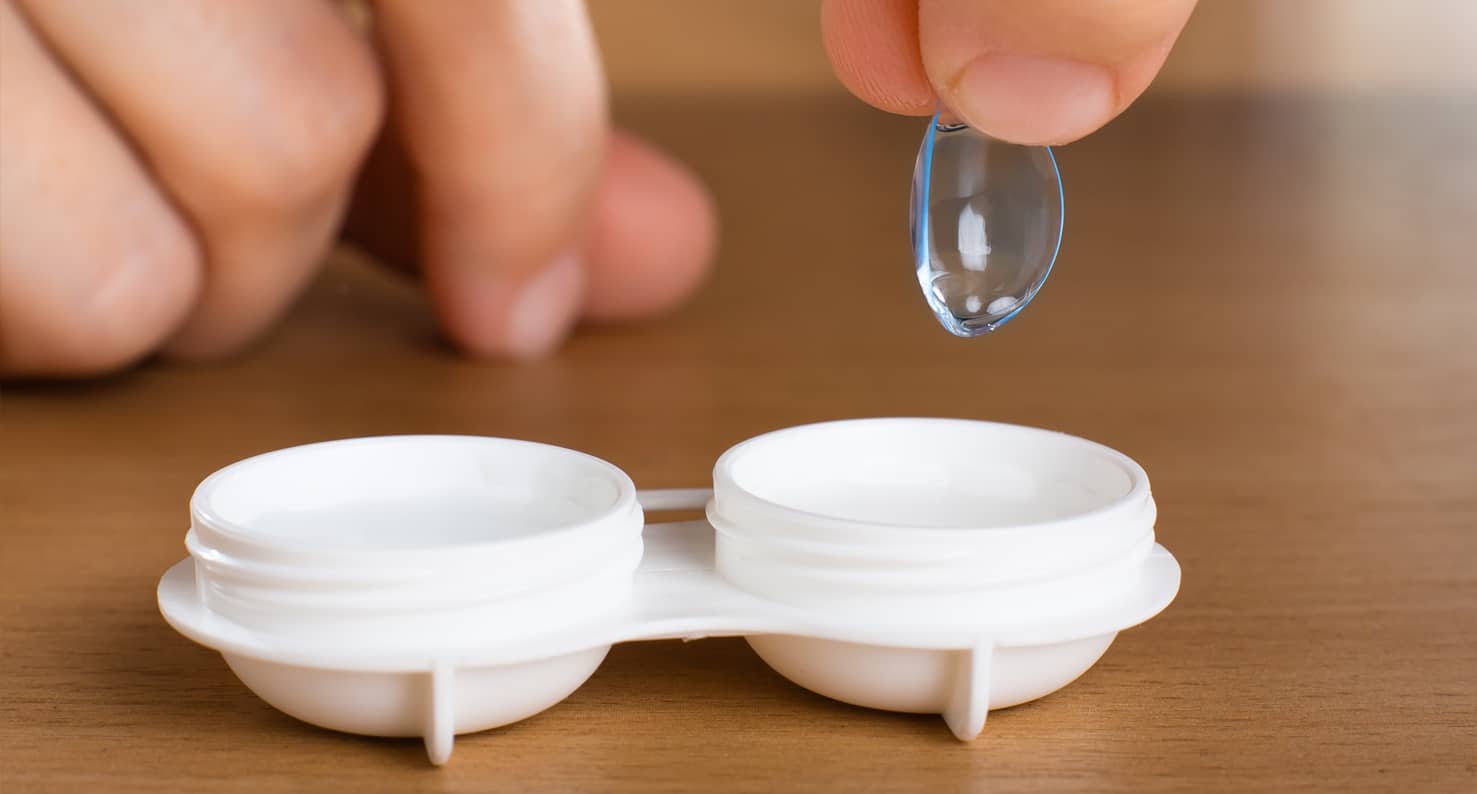What Is Contact Lens Intolerance (CLI)?
Nearly 41 million Americans rely on contact lenses for temporary vision correction, and many prefer them to glasses. However, wearing contact lenses can result in a common and dangerous side effect known as contact lens intolerance (CLI).
Contact lens intolerance is the term used to describe the point at which the eye can no longer tolerate the foreign body (contact lens) that has been in place, and the eye begins to show signs of rejection. Contact lens wearers suffering from CLI are no longer able to apply a contact lens to their eye or wear contacts for any extended time without pain, discomfort, or injury.
Most contact lens wearers who have common refractive errors, such as nearsightedness, farsightedness, and astigmatism, have experienced some form of contact lens intolerance. Though CLI is common, and rates increase with age, it is often an overlooked issue. It can be especially frustrating for those who rely on their contact lenses for clear vision and don’t want to go back to wearing glasses.
If you are experiencing discomfort when wearing contact lenses, it is important to learn the signs of CLI. Read below to learn what physical symptoms can point to the body’s rejection of contact lenses. If you have two or more of these symptoms, schedule an appointment to see an eye doctor like the experts at Kugler Vision to be evaluated.
In the meantime, we encourage you to take this fast CLI self-test to see if you may be experiencing Contact Lens Intolerance. Click the button below. It takes only about 30 seconds.
What Causes Contact Lens Intolerance?

Many factors contribute to this condition. Eyes may develop an intolerance to the contact lens material itself, the solutions used for cleaning, or most commonly the bacteria and fungus that grow on the lenses.
The Centers for Disease Control and Prevention (CDC) conducted a recent survey that shows millions of Americans could be at risk for serious eye infections because of their poor contact lens hygiene. The study found:
- More than 99 percent of the survey respondents reported at least one risky contact lens behavior, such as overuse or poor contact lens hygiene.
- 82 percent reported keeping contact lens cases for longer than recommended.
- 55 percent said they top off solution in the case. In other words, they add new solution to the existing solution instead of emptying the case and cleaning it before adding new solution.
- 50 percent reported that they wore their contact lenses while sleeping.
Poor contact hygiene not only results in serious eye infections but can also lead to contact lens intolerance. Contact lens wearers may wear contact lenses for years before suddenly experiencing CLI. For others, the condition begins and worsens gradually. There are many factors that can contribute to contact lens intolerance, including:
- Dry eye
- Eye allergies
- A lens that is not fitted properly
- Overuse of contacts or poor contact lens hygiene
With the high prevalence of these contributing factors, contact lens intolerance is on the rise.
Risks of Contact Lenses
 It is a common misconception that contact lenses are safer than laser vision correction. In fact, LASIK is safer than contact lenses, and with LASIK you are less likely to develop a serious eye infection.
It is a common misconception that contact lenses are safer than laser vision correction. In fact, LASIK is safer than contact lenses, and with LASIK you are less likely to develop a serious eye infection.
There are numerous complications and risk factors associated with contact lens use, including:
- Serious eye infections that can lead to blindness affect up to one out of every 500 contact lens wearers per year.
- Not following proper contact lens care instructions has been linked to the occurrence of serious eye infections.
- Between 40 percent and 90 percent of contact lens wearers do not properly follow the care instructions for their contact lenses.
- Improper cleaning and irregular replacement of contact lenses and contact lens cases — as well as other behaviors relating to contact lens hygiene and care — have been linked to a higher risk of complications.
- Keratitis — a painful eye infection often linked to improper contact lens use — leads to one million doctor and hospital visits annually, at a cost of $175 million to the U.S. healthcare system.
Symptoms of Contact Lens Intolerance
Some people experience the symptoms of CLI a few times a year, while others suffer the symptoms on a daily basis and can no longer wear contact lenses. This is often when people search for an alternative solution to their contact lenses. The level of discomfort people experience can range from mild to severe, with symptoms including:
- Dryness, itchiness, or scratchiness
- Redness
- Irritation
- Inflammation
- Pain, stinging, or other discomfort when applying contact lenses
- Corneal abrasions
- Corneal ulcers
- Rationing contact lens time
- Resorting to glasses
The severity of CLI depends on the individual. Some people are able to wear contact lenses again after taking a break from them, while others will never be able to wear them again without pain.
At Kugler Vision, we encourage you to see us for an evaluation if you are experiencing symptoms of CLI. Symptoms like these should never be ignored. Don’t allow your eyes to suffer to the point of complete contact lens rejection. If you are experiencing the symptoms of CLI, it’s time to start looking for another solution.
How We Suffer With Contact Lenses
 Healthy eyes need a sufficient amount of oxygen from the environment and tear flow. Since contact lenses sit directly on your cornea, they deprive your eyes of the oxygen they need to remain healthy. If you wear your contact lenses longer than the suggested time, this allows bacteria to collect, and your eyes are more susceptible to infection.
Healthy eyes need a sufficient amount of oxygen from the environment and tear flow. Since contact lenses sit directly on your cornea, they deprive your eyes of the oxygen they need to remain healthy. If you wear your contact lenses longer than the suggested time, this allows bacteria to collect, and your eyes are more susceptible to infection.
According to the FDA, if contact lenses are not cleaned properly, changed appropriately, are worn too long or handled improperly, some sight-threatening infections can occur. Eye pain, blurred vision, and redness are all signs of an inflammation or infection and should be treated immediately by an ophthalmologist.
Wearing contact lenses also limits the amount of moisture in your eyes. Tears are necessary to provide nutrition for the surface of the eye. A lack of moisture in your eyes makes wearing contact lenses uncomfortable and can lead to CLI, serious infections, and corneal ulcers. Wearing contacts limits the eye’s access to the oxygen and moisture you need to see well and keep your eyes comfortable. Your vision is not clear, and you can become susceptible to potentially sight-damaging inflammation.
Find Relief
At Kugler Vision, patients undergo a series of comprehensive tests to determine the best treatment for CLI. If you suffer from dry eyes, our doctors will recommend ways to improve your dry eye symptoms such as drops, vitamins (PRN), Bruder eye hydrating mask, Lipiflow, Blephex, and others.
After CLI is maximally treated, you may be able to go back to contact lenses, or consider upgrading to more natural solutions such as vision correction procedures. At Kugler Vision in Omaha, we care about the health of your eyes. If you are experiencing any discomfort with your contact lenses, or just hate the daily hassles of putting them in and taking them out, we advise you to take our online Contact Lens Intolerance test or please schedule a consultation with us, so we can identify the problem and offer a solution.